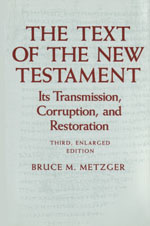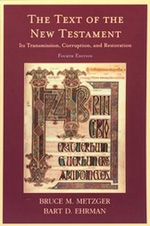Reviews
The Keys to the KingdomBruce M Metzger and Bart H Ehrman. The Text of the New Testament. 4ed Oxford 2005
The following was posted to the WSW list on 14 December 2006.
. . . But the BIG question this season, before which all others pale to insignificance, at which maidens blench and youths cringe, and because of which little children look anxiously at the sky, wondering if it will be the Four Horsemen or the Eight Reindeer that first slide across their moon, is: what about the 4th edition of Metzger's "The Text of the New Testament," whose first three editions have been standbys of the art and its practice, translated into Japanese and Chinese (not to mention Korean, Italian, Russian, and German), and have sounded a note of sense and discretion in the world? What will the new co-author, Bart Ehrman (one of NT's media stars; I have a couple of his CD's) add or subtract? Will it hold? Will it go hip?
Bart got his PhD at Princeton, under the direction of Metzger, and has done a Loeb volume on the Church Fathers. Here is an Apostolic Succession if there ever was one. He has also done a book on the hot new Gospel of Judas. Ehrman's public appearance schedule reads like most people's teaching schedule. Thus is the question balanced. Will purchasers of the new 4th edition find a lump of coal in their mailbox four days later? Or a plum pudding, with old plums refurbished and new ones tastefully added?
On the whole, it is the latter, and those hesitating about the 4ed need do so no longer. Here are a few details.
The 15 worked examples of NT text criticism in practice which made up the final section of the 3rd edition are still there, and still come out the same way, with a few updates as regards footnote references, and a few reconsiderations in the arguments. The key principle of directionality determinations, which is to say, of the adjudication of text variants in general, is still there, at p300 rather than p207, and so is our personal hero Bishop Spyridon, though at p316 rather than at p219. As will be seen, the 4ed has more pages than the old, due in part to new material but also to a more open typeface and thus containing less on each page, though with the "Bible" paper here used, the 4ed is actually slimmer than the 3ed. The body text itself is quite legible, though for the various levels of headings and subheadings, one senses the presence of a "designer" who couldn't keep her hand out of the odd corners of the font box. The paper is whiter, which actually causes slight glare problems in bad light, but with due caution it and the reader's eye should both hold up in use; in most light it is an advantage. The paper has good opacity, which permits the photo illustrations to be portioned out amid the text rather than bunched in a glossy paper section of their own; the placement is good and the new illustrations are helpful. The line is held on the "Western Non-Interpolations," as will rejoice all right-thinking persons. The trouble with committees is that they are never as good as the best person on them. The error of William Farmer in defending the Long Ending of Mark is set forth frankly, as an error, at p323 n1. This (cf 3ed p228 n2) is new material.
Footnotes are still at the bottom of the page; a welcome piece of sanity.
The former Appendices and Additional Notes, placed at the back of the later editions to update the earlier editions, have like the illustrations been distributed to the places where they should have gone, resulting in a slightly less lean text, but rescuing the new material from being overlooked by most readers; on balance a plus. Among the enrichments are references to Bart Ehrman's own work in NT criticism in recent years. His Orthodox Corruption of Scripture (Oxford 1993), in the present writer's opinion, is one of the few recent monographs which have actually moved the subject perceptibly forward. Enough close discussion of specific passages is included that Orthodox Corruption may be used for practice beyond the specimens in Metzger-Ehrman.
The Bibliography of introductions to NT textual criticism at the end has been slightly rearranged for a more strictly chronological order. One minor item has been omitted: Greenlee's Scribes, Scrolls, and Scriptures: A Student's Guide to New Testament Criticism (1985, 102p). Greenlee's useful and compact Introduction to New Testament Textual Criticism (1964; 160p) is retained, however, and will for some beginners be an easier place to start on the subject than Metzger/Ehrman itself. Three items are added at the end: one is in Portuguese, one is negligible, and one is not seen. The picture here implied of the philological vitality of the years between 1990 and 2005 is distinctly discouraging. All the more justification, then, for the respectful refurbishing of Metzger's classic work, for another decade or so of pre-eminence. Unaccountably missing from the Bibliography, unless we credit the operation of modesty on the original author's part, combined with a seemly deference on the part of the new co-author, are Metzger's two Textual Commentaries on the Greek New Testament (United Bible Societies, 1971 and [with Deutsche Bibelgesellschaft] 1994). These are the most extensive NT textual commentaries in existence, and if perhaps not serviceable as ab ovo introductions, they make ideal practice material, and are a handy reference when one has a troublesome passage on hand and cannot remember if it was among the examples in A, or B, or C, or in some commentary on that particular NT book by D. It is to be hoped these volumes will be kept in mind for the not impossible 5th edition.
It is conspicuous to this observer that Hebrew text critics and Greek text critics have little to do with each other, so that neither is aware of the versions of standard problems which are encountered by the other, with consequent loss of possibilities of mutual enlightenment and encouragement. Nor, within Greek, do the Classicals and the Biblicals lunch together. Wilamowitz-Moellendorff's little History of Philology rigidly observes this line; he includes Lachmann, but only for the Pagan side of Lachmann's work, ignoring entirely his contribution to the reconstruction of the Greek NT and his formulation of the principle of text types. In Metzger, Lachmann's NT work is mentioned, though not extensively, but his Germanic studies, his Homeric studies, and his Latin studies, culminating in his masterfully reconstructed Lucretius, might as well not exist. Yet all these are major contributions, and they are instructive, even inspiring, for the future philologist. The future text critic in whatever language, in our opinion, might profitably spend a rainy weekend marooned in some vacation cottage with nothing to read but a mildewed copy of Hall's old Companion to Classical Texts (Oxford 1913). It remains for some future writer to pull the separately erudite corners of the subject together.
As for a general introduction to philology which also takes Chinese examples in stride, well, good luck. And yet, as some on this list will know, the basic error canon recurs, and the basic procedural guidelines still apply, on both sides of the Bactrian entrepot. That larger Kingdom still awaits its Key.
E Bruce Brooks
Warring States Project
University of Massachusetts at Amherst21 Oct 2012 / Contact The Project


